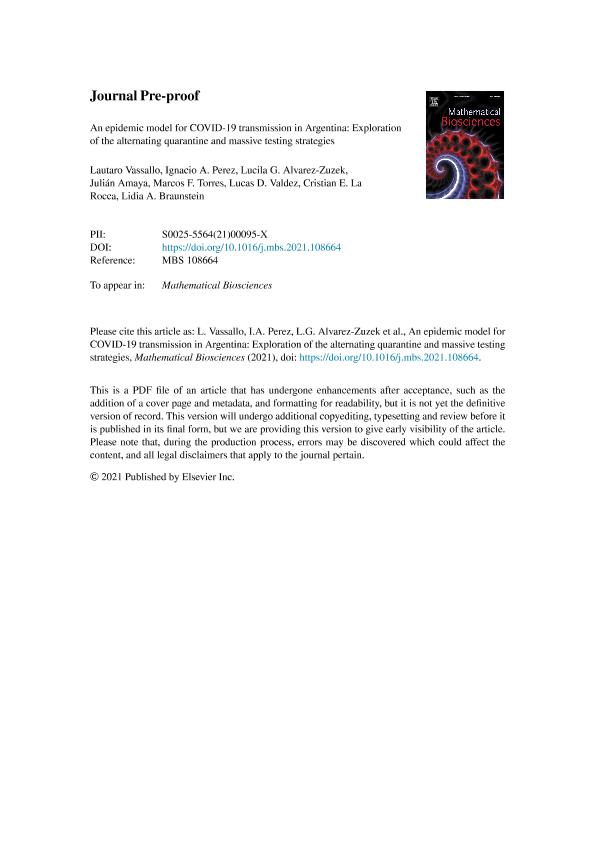Mostrar el registro sencillo del ítem
dc.contributor.author
Vassallo, Lautaro

dc.contributor.author
Pérez, Ignacio Augusto

dc.contributor.author
Alvarez Zuzek, Lucila G.
dc.contributor.author
Amaya, Julián
dc.contributor.author
Torres, Marcos F.
dc.contributor.author
Valdez, Lucas Daniel

dc.contributor.author
la Rocca, Cristian Ernesto

dc.contributor.author
Braunstein, Lidia Adriana

dc.date.available
2021-08-19T13:48:33Z
dc.date.issued
2021-07
dc.identifier.citation
Vassallo, Lautaro; Pérez, Ignacio Augusto; Alvarez Zuzek, Lucila G.; Amaya, Julián; Torres, Marcos F.; et al.; An epidemic model for COVID-19 transmission in Argentina: Exploration of the alternating quarantine and massive testing strategies; Elsevier Science Inc.; Mathematical Biosciences; 7-2021; 1-35
dc.identifier.issn
0025-5564
dc.identifier.uri
http://hdl.handle.net/11336/138515
dc.description.abstract
The COVID-19 pandemic has challenged authorities at different levels of government administration aroundthe globe. When faced with diseases of this severity, it is useful for the authorities to have prediction tools to estimate in advance the impact on the health system as well as the human, material, and economic resources that will be necessary. In this paper, we construct an extended Susceptible?Exposed?Infected?Recovered modelthat incorporates the social structure of Mar del Plata, the 4◦ most inhabited city in Argentina and head ofthe Municipality of General Pueyrredón. Moreover, we consider detailed partitions of infected individualsaccording to the illness severity, as well as data of local health resources, to bring predictions closer to thelocal reality. Tuning the corresponding epidemic parameters for COVID-19, we study an alternating quarantinestrategy: a part of the population can circulate without restrictions at any time, while the rest is equally dividedinto two groups and goes on successive periods of normal activity and lockdown, each one with a durationof days. We also implement a random testing strategy with a threshold over the population. We found that = 7 is a good choice for the quarantine strategy since it reduces the infected population and, conveniently,it suits a weekly schedule. Focusing on the health system, projecting from the situation as of September 30,we foresee a difficulty to avoid saturation of the available ICU, given the extremely low levels of mobility thatwould be required. In the worst case, our model estimates that four thousand deaths would occur, of which30% could be avoided with proper medical attention. Nonetheless, we found that aggressive testing wouldallow an increase in the percentage of people that can circulate without restrictions, and the medical facilitiesto deal with the additional critical patients would be relatively low.
dc.format
application/pdf
dc.language.iso
eng
dc.publisher
Elsevier Science Inc.

dc.rights
info:eu-repo/semantics/openAccess
dc.rights.uri
https://creativecommons.org/licenses/by-nc-nd/2.5/ar/
dc.subject
MATHEMATICAL EPIDEMIOLOGY
dc.subject
COMPARTMENTAL MODELS
dc.subject
COVID-19 IN MAR DEL PLATA
dc.subject
DATA ANALYSIS
dc.subject
COVID-19
dc.subject.classification
Otras Ciencias Naturales y Exactas

dc.subject.classification
Otras Ciencias Naturales y Exactas

dc.subject.classification
CIENCIAS NATURALES Y EXACTAS

dc.title
An epidemic model for COVID-19 transmission in Argentina: Exploration of the alternating quarantine and massive testing strategies
dc.type
info:eu-repo/semantics/article
dc.type
info:ar-repo/semantics/artículo
dc.type
info:eu-repo/semantics/publishedVersion
dc.date.updated
2021-08-18T15:28:03Z
dc.journal.pagination
1-35
dc.journal.pais
Estados Unidos

dc.description.fil
Fil: Vassallo, Lautaro. Consejo Nacional de Investigaciones Científicas y Técnicas. Centro Científico Tecnológico Conicet - Mar del Plata. Instituto de Investigaciones Físicas de Mar del Plata. Universidad Nacional de Mar del Plata. Facultad de Ciencias Exactas y Naturales. Instituto de Investigaciones Físicas de Mar del Plata; Argentina
dc.description.fil
Fil: Pérez, Ignacio Augusto. Consejo Nacional de Investigaciones Científicas y Técnicas. Centro Científico Tecnológico Conicet - Mar del Plata. Instituto de Investigaciones Físicas de Mar del Plata. Universidad Nacional de Mar del Plata. Facultad de Ciencias Exactas y Naturales. Instituto de Investigaciones Físicas de Mar del Plata; Argentina
dc.description.fil
Fil: Alvarez Zuzek, Lucila G.. University Of Georgetown; Estados Unidos
dc.description.fil
Fil: Amaya, Julián. Universidad Nacional de Mar del Plata. Facultad de Ciencias Exactas y Naturales. Departamento de Física; Argentina
dc.description.fil
Fil: Torres, Marcos F.. Consejo Nacional de Investigaciones Científicas y Técnicas. Centro Científico Tecnológico Conicet - Mar del Plata. Instituto de Investigaciones Físicas de Mar del Plata. Universidad Nacional de Mar del Plata. Facultad de Ciencias Exactas y Naturales. Instituto de Investigaciones Físicas de Mar del Plata; Argentina
dc.description.fil
Fil: Valdez, Lucas Daniel. Consejo Nacional de Investigaciones Científicas y Técnicas. Centro Científico Tecnológico Conicet - Mar del Plata. Instituto de Investigaciones Físicas de Mar del Plata. Universidad Nacional de Mar del Plata. Facultad de Ciencias Exactas y Naturales. Instituto de Investigaciones Físicas de Mar del Plata; Argentina
dc.description.fil
Fil: la Rocca, Cristian Ernesto. Consejo Nacional de Investigaciones Científicas y Técnicas. Centro Científico Tecnológico Conicet - Mar del Plata. Instituto de Investigaciones Físicas de Mar del Plata. Universidad Nacional de Mar del Plata. Facultad de Ciencias Exactas y Naturales. Instituto de Investigaciones Físicas de Mar del Plata; Argentina
dc.description.fil
Fil: Braunstein, Lidia Adriana. Consejo Nacional de Investigaciones Científicas y Técnicas. Centro Científico Tecnológico Conicet - Mar del Plata. Instituto de Investigaciones Físicas de Mar del Plata. Universidad Nacional de Mar del Plata. Facultad de Ciencias Exactas y Naturales. Instituto de Investigaciones Físicas de Mar del Plata; Argentina
dc.journal.title
Mathematical Biosciences

dc.relation.alternativeid
info:eu-repo/semantics/altIdentifier/url/https://linkinghub.elsevier.com/retrieve/pii/S002555642100095X
dc.relation.alternativeid
info:eu-repo/semantics/altIdentifier/doi/http://dx.doi.org/10.1016/j.mbs.2021.108664
Archivos asociados
